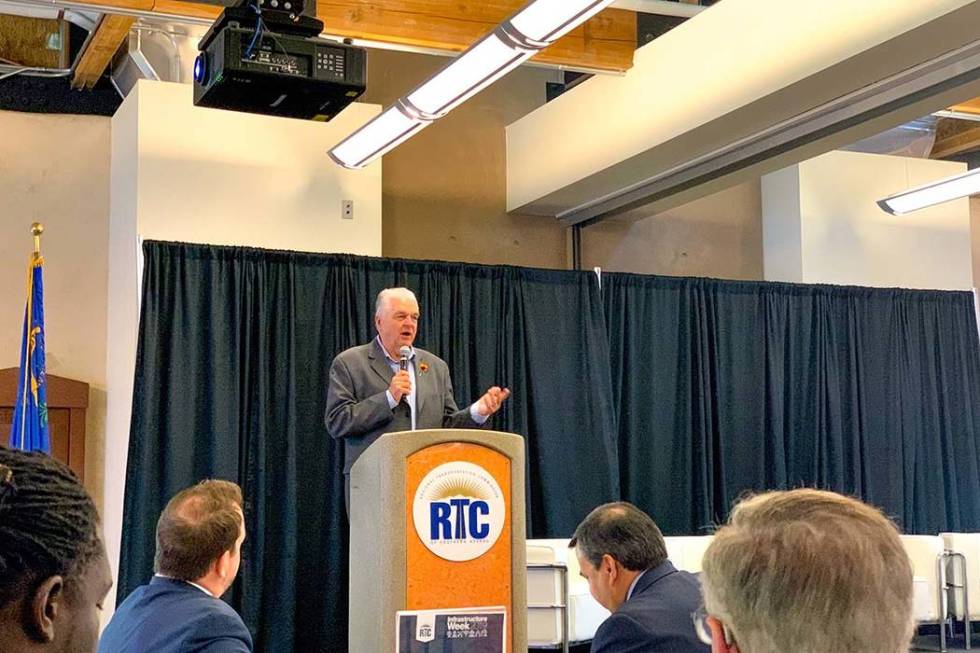Experts: Technology holds key to road infrastructure’s future

Infrastructure plays a big role in any community and all one has to do is look west as they drive on Interstate 15 near Russell Road as evidence to that.
The under-construction $1.8 billion, 65,000 fan capacity domed Las Vegas stadium is well underway, with its massive steel structure taking shape, with 30,000 tons of steel slated to be in place by its summer 2020 completion date.
Infrastructure projects come in a variety of forms as noted Monday morning at the Western Summit of the National Infrastructure Week hosted by the Regional Transportation Commission of Southern Nevada at Springs Preserve, with transportation being, outside of a massive stadium rising from out of the ground, the most noticeable.
Gov. Steve Sisolak was joined by federal, regional and local transportation leaders to discuss the future of infrastructure projects.
Timing was on the group’s side, as the nearly $1 billion Project Neon sits at 96 percent complete. Sisolak said it will take similar projects to ensure Southern Nevada keeps moving along with a focus on mitigating traffic congestion.
“We’re getting busier and busier and we need to keep the Nevada Department of Transportation and the Regional Transportation of Southern Nevada on the front of this so that we can provide adequate transportation in a reasonable timeframe,” Sisolak said. “We don’t want this (Las Vegas Valley) to turn into gridlock.”
A lot of attention at the event was placed on technology’s role in the infrastructure of the future. Former Nevada governor Brian Sandoval was a big proponent of utilizing the latest technology to advance transportation in the region, playing a large role in getting autonomous vehicle testing rolling in the Las Vegas Valley.
Sisolak said technology is an important aspect of the transportation picture, but he isn’t as bullish as his predecessor.
“Technology is important, but it isn’t the end all, do all,” he said. “We need to do more to make sure our bridges and roads are adequate and they’re safe and in a condition that makes them easy to travel in.”
Utilizing technology
Nevertheless, a panel discussion focused on the role technology can play in helping traffic flow as roads can be widened only so much before the work carried out is negated.
Roger Millar, Washington State Department of Transportation secretary, said the department is employing technology to combat traffic congestion, which he deemed a “reality in a successful economy.”
“We’ve invested over $1 billion in the transportation system in the Seattle area,” Millar said.
Washington DOT has increased lane capacity on its busiest freeways by 35 percent by utilizing technology, bus rapid transit and express toll lanes, he added.
“We did it with cameras and toll lanes and it’s paying for itself,” Millar said. “So smart technology, the application of smart technology makes sense.”
Utilizing technology can lead to fewer crashes, according to Shailen Bhatt, president and CEO of the Intelligent Transportation Society of America. For example, connected vehicles — “that’s vehicles talking to infrastructure” — can keep crashes from occurring, he said.
Super computers and artificial intelligence are key ways technology is being used to decrease the occurrence of motor vehicle crashes, the panelists agreed, with Las Vegas being no stranger to such uses.
Pilot program
Las Vegas, the RTC and the Nevada Department of Transportation teamed up with Israeli startup Waycare on a pilot program that uses in-vehicle information, existing cameras, sensors and other traffic-related data to develop predictive analytics designed to reduce traffic fatalities and crash-related congestion.
The yearlong pilot program resulted in a 17 percent reduction in crashes along a stretch of Interstate 15, according to the RTC.
“That has really opened our eyes to not only be able to anticipate where congestion might occur, and how to deal with it, but also being able to respond a lot faster,” said David Swallow, RTC’s senior director of engineering and technology.
After the successful trial, RTC is going to expand the project’s scope to incorporate additional freeways and major arterials in the Las Vegas Valley, such as Tropicana Avenue and Flamingo Road, Swallow said.
Millar pointed out technology’s advantage by highlighting the Katy Freeway in Houston as a prime example of how building out roads doesn’t always equate to easing traffic. The freeway was expanded from eight lanes to 23 lanes in 2008 but it has actually increased travel time instead of reducing it.
“Three years after the highway opened, it takes longer to get from one end of it to the other end of it than it did before construction started,” Millar said.
Contact Mick Akers at makers@reviewjournal.com or 702-387-2920. Follow @mickakers on Twitter.